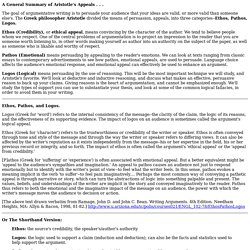

Mentor Text Wednesday: China’s Web Junkies Op-Doc. Mentor Text: “China’s Web Junkies,” an Op-Doc from The New York Times Skill: Using evidence to support a position Background: Every year it seems that more and more of my students are denouncing Facebook.

They talk about it freely during passing time as they unpack their bags. “You’re still on? “Yeah,” another student chimes in. Sometimes the things we hear our students say in passing can be great fodder for important classroom and life lessons. The Op-Doc “China’s Web Junkies” looks at the internet addiction problem of Chinese youth. Federico Morando under Creative Commons lic How To Use It: You might begin by reading a passage from Sherry Turkle’s Alone Together: Why We Expect More From Technology and Less from Each Other. Other Uses: Join us TOMORROW, Thursday, March 13 at 7:30pm EST for a #movingwriters chat to talk about using mentor texts & teaching students to use them on their own! - Allison. Ethos, Pathos, and Logos. A General Summary of Aristotle's Appeals . . .

The goal of argumentative writing is to persuade your audience that your ideas are valid, or more valid than someone else's. The Greek philosopher Aristotle divided the means of persuasion, appeals, into three categories--Ethos, Pathos, Logos. Ethos (Credibility), or ethical appeal, means convincing by the character of the author. We tend to believe people whom we respect. One of the central problems of argumentation is to project an impression to the reader that you are someone worth listening to, in other words making yourself as author into an authority on the subject of the paper, as well as someone who is likable and worthy of respect. Pathos (Emotional) means persuading by appealing to the reader's emotions. Logos (Logical) means persuading by the use of reasoning. Ethos, Pathos, and Logos. Ethos (Greek for 'character') refers to the trustworthiness or credibility of the writer or speaker. Or The Shorthand Version: 4 Ways to Write a Rhetorical Analysis.
Edit Article Gathering InformationWriting the IntroductionWriting the BodyWriting the Conclusion Edited by ViolinLoveForever, Julia Goff, Shina, Ron D and 3 others A rhetorical analysis can be written about other texts, television shows, films, collections of artwork, or a variety of other communicative mediums that attempt to make a statement to an intended audience.

In order to write a rhetorical analysis, you need to be able to determine how the creator of the original work attempts to make his or her argument. You can also include information about whether or not that argument is successful. Ad. Free K-12 Lesson Plans, materials and resources. Logos, Ethos and Pathos: 3 Ways to Appeal to an Audience in Essays.
Rhetori-WHAT?: Teaching Rhetorical Analysis to High School Juniors. Those of you who teach AP English Language are probably not impressed with the title of this blog.

Rhetoric is the heart and soul of our curriculum. The juniors I speak of are not AP students. Rather, in this post, I will outline a method I developed for teaching my students in standard English about rhetoric and how to analyze its use in writing. I spend about a week introducing the terms and having students identify how and where the terms can be used. You can really play with this portion of the unit depending upon how you teach new concepts and terms. First, I hand them one of the "Nacirema" lectures. Here's your moment. When you say, let's write, they'll be upset for a minute, but they'll get over it. "Your analysis will...___ Discuss the use of 2-3 rhetorical terms ___ Define each term ___ Provide an example for each term from the text ___ Explain how the example is representative of the term" Slow down. "Your analysis will...___ Explicitly state the author's main idea. Www.cvsd.org/university/classes/eng/alentz/documents/rhetorical vocab..pdf.
Thou shalt not commit logical fallacies. Identifying and Understanding the Fallacies Used in Advertising. Finding Common Ground: Using Logical, Audience-Specific Arguments. ReadWriteThink couldn't publish all of this great content without literacy experts to write and review for us.

If you've got lessons plans, activities, or other ideas you'd like to contribute, we'd love to hear from you. More Find the latest in professional publications, learn new techniques and strategies, and find out how you can connect with other literacy professionals. More Teacher Resources by Grade Your students can save their work with Student Interactives. Analyzing Famous Speeches as Arguments. ReadWriteThink couldn't publish all of this great content without literacy experts to write and review for us.

If you've got lessons plans, activities, or other ideas you'd like to contribute, we'd love to hear from you. More Find the latest in professional publications, learn new techniques and strategies, and find out how you can connect with other literacy professionals. More Teacher Resources by Grade Your students can save their work with Student Interactives. More Home › Classroom Resources › Lesson Plans Lesson Plan Overview.